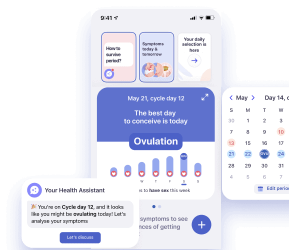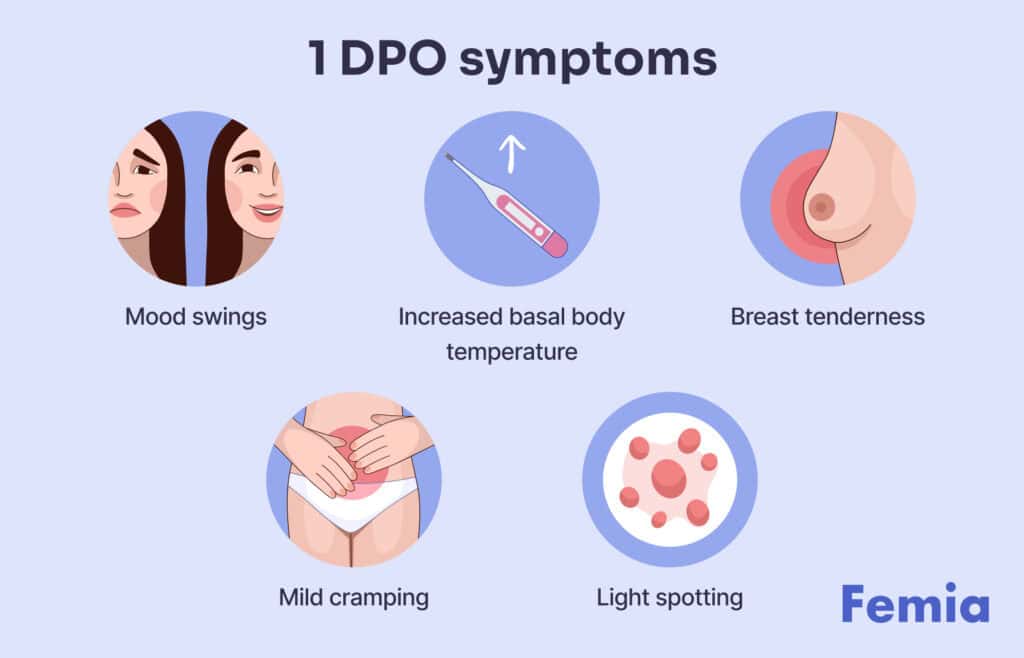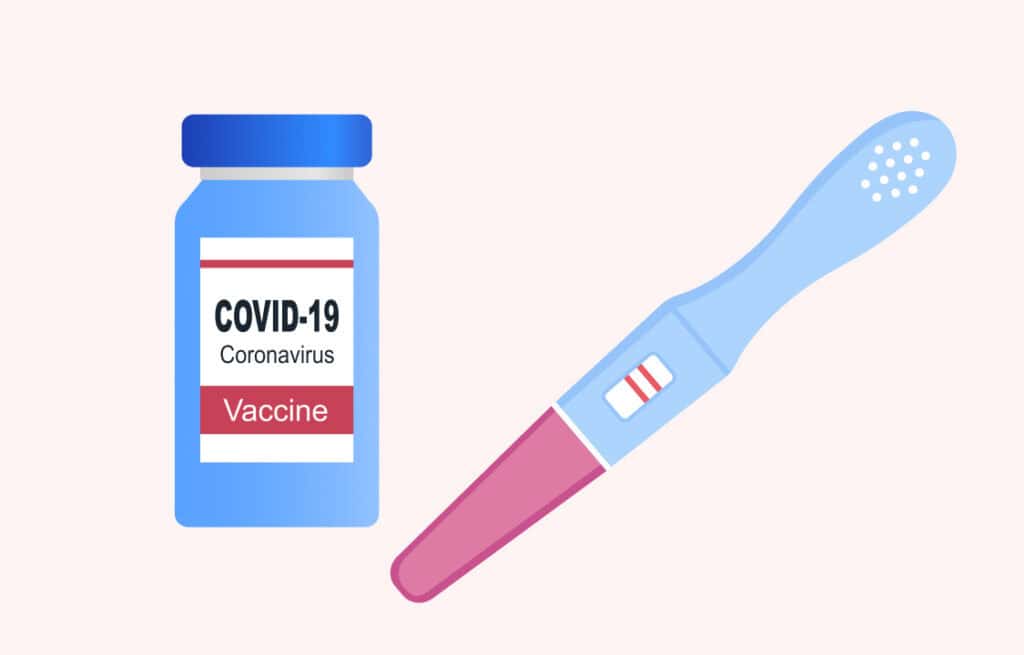Femia > Health Library > Getting Pregnant > Trying to conceive > 1 DPO: What to expect, and how to tell if you’re pregnant
1 DPO: What to expect, and how to tell if you’re pregnant

- Updated Feb 27, 2025
- Published
CRAFTED BY HUMAN
Crafted by human At Femia, we provide accurate and up-to-date information at every stage of your journey, from trying to conceive, pregnancy and postnatal support. All content is created by a real person based on in-depth research and own professional experience. Femia ensures that you will receive expert advice, strict accuracy and a personalized approach from our authors/medical experts. Learn more about our editorial policy.
FACT CHECKED
Fact checked At Femia Health, we maintain the highest standards of editorial excellence in delivering content focused on helping you conceive, guiding you through pregnancy, and supporting you postpartum. Explore our content review principles to learn how we ensure the accuracy and quality of our health and lifestyle tips for every stage of your journey.
1 DPO (day post ovulation) marks the start of the two-week wait period. At this stage:
- The egg is still viable for 12-24 hours, allowing a last chance for fertilization.
- Hormonal changes begin, with rising progesterone levels.
- Common symptoms may include mild cramping, mood swings, or breast tenderness.
- Early pregnancy symptoms are unlikely, as implantation hasn’t occurred yet. It’s too early for accurate pregnancy tests.
After the ovulation, follows a period which women trying to conceive (TTC) commonly call the two-week wait. This is the period after ovulation and all the way to your (hopefully) missed period. During this phase, mothers-to-be often carefully watch symptoms and count their days after ovulation anticipating their awaited pregnancy.
Days post ovulation or DPO is associated with certain changes in your body and can be marked with different symptoms and early pregnancy signs. To help you understand your cycle better, we’ve prepared a series of articles covering every DPO.
In this article, we’re going to explain to you the 1 DPO meaning and tell you about some things you can expect during this stage.
➡️ Read other Femia guides in this series:
- 2 DPO: What to expect, and how to tell if you’re pregnant
- 3 DPO: What to expect, and how to tell if you’re pregnant
- 4 DPO: What to expect, and how to tell if you’re pregnant
- 5 DPO: What to expect, and how to tell if you’re pregnant
- 6 DPO: What to expect, and how to tell if you’re pregnant
- 7 DPO: What to expect, and how to tell if you’re pregnant
- 8 DPO: What to expect, and how to tell if you’re pregnant
- 9 DPO: What to expect, and how to tell if you’re pregnant
- 10 DPO: What to expect, and how to tell if you’re pregnant
- 11 DPO: What to expect, and how to tell if you’re pregnant
- 12 DPO: What to expect, and how to tell if you’re pregnant
- 13 DPO: What to expect, and how to tell if you’re pregnant
- 14 DPO: What to expect, and how to tell if you’re pregnant
- 15 DPO: What to expect, and how to tell if you’re pregnant
- 16 DPO: What to expect, and how to tell if you’re pregnant

What does 1 DPO mean?
The abbreviation DPO stands for “days post ovulation,” which occurs during your cycle’s luteal phase. 1 DPO is the first day after your ovulation occurs, 2 DPO is the second day, and so forth.
Importance of tracking DPO for conception
If you are trying to conceive for some time, tracking DPO can offer multiple benefits:
- It ultimately means that you will be tracking your ovulation as well, which can help you understand your fertility window, find the optimal time for conception, and maximize your chances.
- Regular tracking of ovulation and DPO can help you spot any potential irregularities in your cycle and address them early. Eventually, it can help you improve your future cycles for easier conception.
- Understanding the concept, symptoms, and internal changes that happen in your body during every day post ovulation can help you monitor early pregnancy signs.
- By knowing your body’s cycles and changes during ovulation and beyond, you can undertake new habits and adjust your lifestyle for better reproductive health and easier conception.
- It can help reduce anxiety and uncertainty during different phases of your cycle, hence, supporting your emotional health and helping you make more informed fertility decisions.
👉Find out more: How to improve egg quality: Tips for boosting fertility at any age
1 DPO: what is happening in your body?
1 day post ovulation marks the end of your fertility window. As the egg your ovary releases during ovulation moves down the fallopian tube, it remains available for around 12-24 hours, though its viability decreases rapidly. Hence, 1 DPO is the critical point that determines whether your egg will be fertilized or not.
If you and your partner have had sex during your fertility window (or you have used assistive reproductive technology at this time) and sperm entered into your reproductive tract, it can remain viable for up to five days. During 1 DPO the egg will be available for sperm to fertilize it. If fertilization happens, it will travel toward the uterus and begin dividing into more cells, forming an embryo. However, if sperm doesn’t fertilize the egg, it will disintegrate and become unable to lead to pregnancy.
Implantation doesn’t happen at this stage. The egg reaches the uterus in about 6-7 days after fertilization and implantation starts after about 7 days, so it typically doesn’t happen before 6 DPO.
1 day post ovulation also marks the start of your cycle’s luteal phase, which means there are certain changes happening in your hormone levels. This phase of the cycle is predominated by the luteal hormone progesterone and estrogens. The increase in hormones affects your body in two ways:
- Your uterine lining is getting thicker to prepare for implantation and pregnancy if fertilization happens.
- Cervical mucus thickens due to increased progesterone to help prevent bacteria from getting inside your uterus. Hence, 1 DPO discharge may be thick and sticky.
Common 1 DPO symptoms
1 DPO is the first day of the two-week phase that takes place between your ovulation and the next period. Hence, the symptoms on this day may not be too prominent, especially if you are looking at symptoms related to early pregnancy.
If you’re trying to get pregnant, we understand that you are probably looking for signs of pregnancy, but 1 DPO is generally too early to notice them.
Some mild 1 DPO symptoms that you may experience are explained by the changing hormone levels and are normal signs of your luteal phase. Here are what these symptoms can be:
- Mood swings. Progesterone might affect your emotional processing and cause irritability.
- Increased basal body temperature. While preparing your uterus for pregnancy, progesterone might slightly increase your basal temperature and this might become noticeable already at 1 DPO.
- Breast tenderness. Progesterone stimulates female milk glands and often causes fluid retention, whereas estrogen stimulates female milk ducts. Together, these hormones can lead to a feeling of heaviness and sensitivity.
- Mild cramping during 1 DPO. Some females may notice slight abdominal cramping caused by the release of the egg during ovulation.
- Light spotting. In rare cases, females can observe light spotting. This is caused by changes in estrogen and progesterone levels during egg release.

While all these symptoms might be felt during 1 day post ovulation, it’s important to note that they are typically barely noticeable as you just enter your luteal phase. Hence, the symptoms, as well as their intensity and duration, might differ drastically from one woman to another.
Also, it’s important to note that all of these symptoms are not exclusive to 1 DPO and can occur at various points in your cycle.
1 DPO symptoms if pregnant
If you are trying to conceive, it’s natural to look out for early pregnancy signs, and tracking DPO can help detect them. However, you shouldn’t expect to see prominent pregnancy symptoms during 1 DPO.
Your luteal phase’s early stage is when the egg might get fertilized but is not implanted yet, which means that pregnancy doesn’t occur yet.
Also, the levels of progesterone only peak at 6–8 days after ovulation (even if there is no pregnancy), which is why tangible symptoms typically don’t show earlier.
Can I take 1 DPO pregnancy test, or is it too early?
If you’ve noticed some general luteal phase symptoms, which might be similar to pregnancy signs, you might feel tempted to take a pregnancy test early on. However, it’s not recommended to do this.
1 to 3 DPO is generally considered too early to be able to perform an accurate pregnancy test. Even highly sensitive tests used in the doctor’s office may not be able to detect pregnancy at this stage. Taking a 1 DPO pregnancy test can lead to receiving false-negative or false-positive results.
👉Find out more: How long after sex does implantation occur: Understanding the timeline
Tips for 1 day post ovulation and beyond
Starting from 1 DPO, you get into your two-week wait phase. Before this phase, you might’ve done some preparation, such as cycle tracking and ovulation estimations to detect the perfect time to conceive and now you might be looking forward to finding out if you’re pregnant.
These expectations can make the two-week wait feel like this time seems to move incredibly slowly. And while you may not have any tangible symptoms to address yet, at your 1 DPO, there are a few recommendations you can consider to reduce the pressure:
- The two-week wait can make you experience a true rollercoaster of emotions that can go from excitement to anxiety and back in no time. Consider integrating stress management techniques into your life to help reduce the tension and manage your emotions. Some common tactics include deep breathing, meditation, and yoga.
- Consider staying open and honest with your partner, share your feelings, and talk through every worry, expectation, and other things. Your emotional intimacy can greatly help you cope with conception, the two-week wait, and pregnancy with less stress.
- Continue tracking symptoms during and beyond 1 DPO. This can help you stay in tune with your body and detect any important changes that occur in it. However, try not to over-analyze what you feel, especially during the first days post ovulation because symptoms might not be prominent yet.
- Don’t do anything you would’ve avoided during pregnancy. Starting from 1 day post ovulation, your baby-to-come might be already making its way to the uterus so it’s a good idea to err on the side of caution. Avoid smoking, alcohol, and foods recommended to avoid during pregnancy. Also, consider steering clear from high-impact exercise and other activities that may harm a new pregnancy. Instead, pick up healthy dietary habits, stick to gentle exercise, and integrate other self-care practices to prepare for and support a healthy pregnancy.

Questions from the Femia community
During 1 DPO can I still get pregnant?
Yes. The egg released during ovulation is viable (can be fertilized) for up to 12 and 24 hours. That is, at 1 DPO you can still get pregnant if you have had a sexual intercourse or assisted reproduction technology session in the five days before or 24 hours after ovulation, while the egg is still possible to fertilize. However, conceiving during this period might be less likely compared to the actual day of ovulation due to reducing viability of the egg.
Why am I cramping 1DPO?
Ovulation and post-ovulation cramps are natural. They may occur because of a follicle rupture during the egg release. Also, some females may experience mild cramping due to changing hormonal levels.
Is it okay if I notice spotting 1 DPO?
In some rare cases, fluctuations in estrogen and progesterone levels associated with rupture of the following during ovulation might result in slight spotting or discharge. If you notice it during 1 DPO and feel concerned about it, consider consulting with your healthcare provider.
Can I experience 1 DPO nausea?
During 1 DPO, you might start experiencing different symptoms (frequently mild), such as mood swings, cramping, breast tenderness, and others. These symptoms are mostly related to hormonal changes. However, early pregnancy signs, including nausea and vomiting typically don't show until the fertilized egg is implanted.
Can I spot pregnancy by 1 DPO cervical mucus?
The changes in color and consistency of your cervical mucus can be early indicators of pregnancy. During 1 DPO, your mucus may get thicker and stickier. However, it might be too early to tell if it’s an early sign of pregnancy because it's natural for mucus to get thicker post-ovulation.
The bottom line
1 DPO is the first day after you ovulate. During this time, you might still get pregnant or have your fertilized egg move down the fallopian tube to implant and develop as an embryo.
Generally, before the implantation happens, which is not earlier than 6 DPO, you’re not actually pregnant yet and it is unlikely to see any early pregnancy signs or get accurate test results. However, if the egg is fertilized, 1 DPO can mark the beginning of your pregnancy journey.
After reading this guide, you know about the changes that happen in your body during this stage, possible symptoms that you can experience, and handy tips for having a healthy journey.
➡️ Read other Femia guides in this series:
- 2 DPO: What to expect, and how to tell if you’re pregnant
- 3 DPO: What to expect, and how to tell if you’re pregnant
- 4 DPO: What to expect, and how to tell if you’re pregnant
- 5 DPO: What to expect, and how to tell if you’re pregnant
- 6 DPO: What to expect, and how to tell if you’re pregnant
- 7 DPO: What to expect, and how to tell if you’re pregnant
- 8 DPO: What to expect, and how to tell if you’re pregnant
- 9 DPO: What to expect, and how to tell if you’re pregnant
- 10 DPO: What to expect, and how to tell if you’re pregnant
- 11 DPO: What to expect, and how to tell if you’re pregnant
- 12 DPO: What to expect, and how to tell if you’re pregnant
- 13 DPO: What to expect, and how to tell if you’re pregnant
- 14 DPO: What to expect, and how to tell if you’re pregnant
- 15 DPO: What to expect, and how to tell if you’re pregnant
- 16 DPO: What to expect, and how to tell if you’re pregnant
References
- Patricio C. Gargollo. “How long do sperm live after ejaculation?” Mayo Clinic, 5, May, 2022. https://www.mayoclinic.org/healthy-lifestyle/getting-pregnant/expert-answers/pregnancy/faq-20058504#:~:text=Ejaculated%20sperm%20remain%20viable%20for,decades%20when%20semen%20is%20frozen.
- “How Pregnancy Happens.” Planned Parenthood. https://www.plannedparenthood.org/learn/pregnancy/how-pregnancy-happens#:~:text=If%20a%20sperm%20cell%20does,3–4%20days%20after%20fertilization.
- “Luteal Phase.” Cleveland Clinic, 4, Nov. 2022. https://my.clevelandclinic.org/health/articles/24417-luteal-phase.
- Inger Sundström-Poromaa, Erika Comasco, Rachael Sumner, Eileen Luders. “Progesterone – Friend or foe?” Frontiers in Neuroendocrinology, Volume 59, ScienceDirect, 2020. https://www.sciencedirect.com/science/article/pii/S0091302220300479.
- “Basal Body Temperature.” Cleveland Clinic, 19, Dec. 2022. https://my.clevelandclinic.org/health/articles/21065-basal-body-temperature.
- “Stress management.” Mayo Clinic, 26, Oct. 2023. https://www.mayoclinic.org/tests-procedures/stress-management/about/pac-20384898.
- “Foods to avoid in pregnancy.” The National Health Service (NHS), 19, May, 2023. https://www.nhs.uk/pregnancy/keeping-well/foods-to-avoid/.

Learn when it’s safe to have sex after a miscarriage or D&C. Understand the physical and emotional recovery needed, guidelines, and tips for resuming intimacy safely.

Kansas has filed a lawsuit against Pfizer, alleging misinformation about its COVID-19 vaccine’s safety and effectiveness, including during pregnancy. Learn more about the claims, evidence, and implications.

Discover tips and strategies for getting pregnant naturally with endometriosis. Learn the best times to try after surgery and how to improve your chances of conception.

